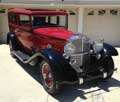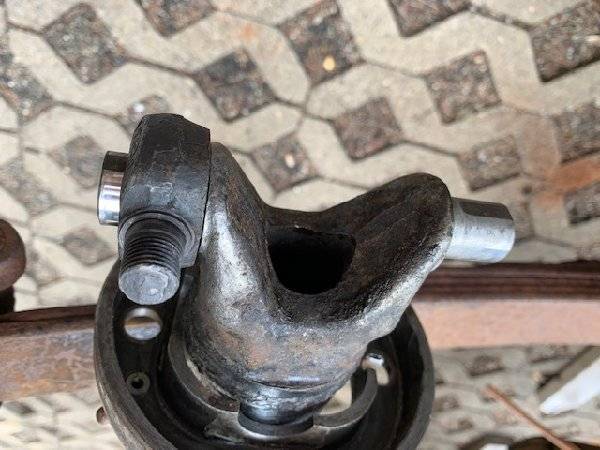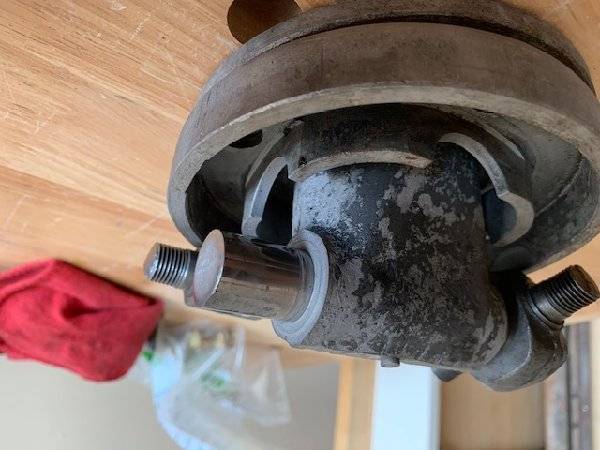|
Re: 1928 driveshaft diameter
|
||||
|---|---|---|---|---|
|
Home away from home

|
I solved the driveshaft problem on my 901 by having a new one made with modern components. This involved having blank flanges for both the rear & transmission end made.
Posted on: 2019/6/29 14:51
|
|||
|
||||
|
Re: 1928 driveshaft diameter
|
||||
|---|---|---|---|---|
|
Home away from home
|
The trunions are heat treated but not fully hardened. Fully hard is 50-62 HRC, the trunions are probably around 38 to 45 HRC. Heat treating makes them tough but not brittle, fully hard they would be brittle.
They can be bored out using carbide tooling, CBN, or you could have them wire cut, EDM machined to accept bushings. Just be careful not to remove to much material to weaken them. Another option would be to have the pin portion metal (thermal) sprayed and ground. The trunion bores would be machined first to clean them up and establish the size the pins would later be ground to. Jig grinding the trunion bores would be one option if you went the metal spray route. Info about the metal (thermal) spray process: ust.com.au/thermal-spray.html thermalspray.com/applications/repair-and-dimensional-restoration/ empire-cat.com/Service/Precision_Machining/Thermal_Spray.aspx vacaero.com/information-resources/vac-ae ... epair-of-service-damaged-parts.html
Posted on: 2019/6/30 6:20
|
|||
|
||||
|
Re: 1928 driveshaft diameter
|
||||
|---|---|---|---|---|
|
Home away from home
|
Posted on: 2019/6/30 10:34
|
|||
|
||||
|
Re: 1928 driveshaft diameter
|
||||
|---|---|---|---|---|
|
Home away from home
|
My machinist stated he could not bore out the trunions as they were too hard. He did not state the hardness but said a file could not even scratch the surfaces. When asked if the trunion pin could be replaced he noted that unless it was then heat treated it would wear out quickly. I have decided that I will take the best of both assemblies and put together one driveshaft to use. If I then have further issues later, I will go for fabricating a new driveshaft with modern UJoints.
Still curious about the different diameter between the Australian and US shafts.
Posted on: 2019/6/30 12:23
|
|||
|
||||
|
Re: 1928 driveshaft diameter
|
||||
|---|---|---|---|---|
|
Forum Ambassador
|
No clue on the driveshaft but one thing you notice when looking thru parts books is a lot of different components for export cars. 12v in the case of some, different shock valving or heavier duty shocks for others and I think there is even a few junior model export components that have the same part numbers as senior components.
IIRC, there was an article written by one of the prominent auto writers of a few years back that said the heavier components on export cars were needed for road conditions in some other countries and that because mfgs didn't know exactly where the cars would wind up they shipped for worst case. I know American roads in lots of places were very bad in the 20s and 30s but is it possible Australian roads were worse or non existent in a large part of the country and needed the heavier driveshaft? Another question is where was the Australian car assembled. Perhaps it was a non US assembly and a locally sourced part was used or an import agent had determined from experience the stock item was insufficient and had it made up.
Posted on: 2019/6/30 12:49
|
|||
|
Howard
|
||||
|
||||
|
Re: 1928 driveshaft diameter
|
||||
|---|---|---|---|---|
|
Home away from home

|
I should have mentioned that I had parts from several drive shafts. I was going to have a good one made up from them, which would have involved cutting and welding the parts together. I could not find a local source that had ability to balance the shaft afterwards without fabricating flanges for their machine. The cost of making these flanges with the cost of welding a shaft from the parts was very close to the cost of a new shaft with modern components, which was ~$675.00).
Also, the company I used was the one mentioned by Tom in post #4. BTW - I was very pleased by the support and service I received from them.
Posted on: 2019/7/1 12:58
|
|||
|
||||

 (46.19 KB)
(46.19 KB)









